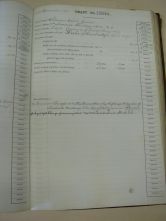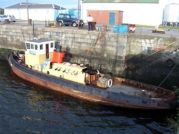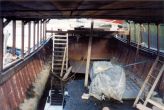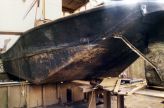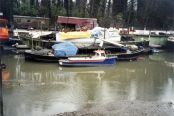Duke of Cambridge - Craft log
From the Log it can be seen that the vessel was in registered and in service on January 1902, which must have meant that the vessel was built prior to that date in 1901. As the actual date of construction is not know, this represents the best provenance of the build date, thought the lighter could have been built significantly before this date.
As you can see, the owners name was William Cecil Gunn of 7 Laurence Pountney Hill E6. This road still exists and is in the heart of the City of London at EC4R, next to London Bridge Station and Canon Street.
Unfortunately Mr Gunn did not own the vessel for long as it was transferred to the Thames Steam Tug and Lighterage Co Ltd in 1906 and poor Mr Gunn died in 1918.
15090 THE LONDON GAZETTE, 24 DECEMBER, 1918.
NOTICE is hereby given, that all creditors andother persons having any debts, claims ordemands against the estate of William Cecil Gunn,late of The Red House Biokley, in the county of Kentl(who died on the 13th day of September, 1918, andthe Principal Registry of the Probate Division of HisMajesty's High Court of Justice-, on the llth day ofDecember, 1918, by Alice Harding Gunn and the PublicTrustee, the executors therein named), .are hereby requiredto send particulars, in writing, of their debts,claims or demands to us, the undersigned, as Solicitorsto the said executors, on or before the 25th day ofJanuary, 1919, after which date the said executors willproceed to distribute the assets of the said deceasedamongst the persons entitled thereto, having regardon-ly to the debts, claims and demands of which theyshall then have had notice; and that they will not beliable for the assets, or any part thereof, so distributed,to any person.or persons of whose debt, claim.or demandthey shall not then ha,ve had notice.—Dated this21st day of. December, 1918.So what happen next?
THAMES AND GENERAL LIGHTERAGE CO LTD
Including Thames Steam Tug and Lighterage Co Ltd. General Lighterage Co Ltd.
THAMES STEAM TUG AND LIGHTERAGE COMPANY
Although a few records exist showing the company tugs towing small ships in the early years it was essentially a lighterage company. A prospectus was issued on July 9th 1856 showing a capital of £200,000 and advertising an issue of twenty thousand £10 shares. The Directors were Thomas Brassey, John Blake, Horatio Day, Sir S Morton Peto, William Swann and W H Tyler. Managers were Messrs Keen and Blake of Northumberland Wharf, Brentford. Company secretary Charles Eley Jnr. was also secretary of the Great Western and Brentford Railway Company. The stated aim of the company was to provide a fleet of lighters and steam tugs to take advantage of the ever increasing lighterage traffic on the Thames, and in particular to capitalize on traffic from the newly opened Victoria Dock, possible traffic from a proposed new dock at Dagenham, and that from a dock at Brentford, operated in collaboration with the GWR to take advantage of the Welsh coal trade. It is also evident from the prospectus that this was a re-financing and expansion of an existing lighterage business, presumably that of Keen and Blake of Brentford and Isleworth.
The company commenced operation on the first day of December 1856 with offices at Northumberland Wharf, Brentford, and Corn Exchange, London. In 1857 it announced it had reached an agreement with the Victoria Dock Company to service all its lighterage requirements. In December 1857 the Head office moved to 148 Fenchurch Street, London. Growth seems to have been fairly rapid and by 1881 the company employed over 300 men. By 1889 the offices had moved to 65 Fenchurch Street and company secretary was T. W. Jacob. T W Jacob was with the company many years, being both secretary and manager in 1889 and managing director by 1902.
The workforce went on strike in November 1881 over pay and conditions and similar disputes were to arise in 1889 and from October 1900 to January 1901.
In 1904 the company was in conference with various bodies, including Thames Conservancy regarding plans to build a barge repair yard on Lot’s Eyot near Brentford, a small islet which they owned. In December 1904 the company owned 340 barges and five tugs. Trading continued through various ups and downs including the two World wars and on 16th March 1959 a large notice appeared in the Times celebrating the companies centenary. By 1961 however there was a downturn in business beginning, and although employing over 400 lightermen a take-over bid of £780,000 from the Transport Development Group, announced on the 3rd October, was recommended and accepted. An amalgamation with the General Lighterage Company was to follow and in 1980 the whole setup was taken over by William Cory Ltd.
In 1972 Ocean Group plc bought Cory. In 1979 Cory bought Thames and General Lighterage, making Cory the largest waste carrier on the Thames. In the 1980s Cory withdrew from coal and oil distribution to concentrate on waste transport and disposal. In 1981 two Cory group companies were merged to form Cory Waste Management. Cory Environmental Municipal Services Ltd was formed in 1989 and the two companies were merged as Cory Environmental in 1990. In 1997 Cory Environmental grew by buying Local Authority Waste Disposal Companies from Essex County Council and Gloucestershire County Council. In 1999 Cory bought Parkhill Reclamation, increasing Cory's presence in the West Midlands and North West England.
In 2000 Ocean Group plc merged with NFC plc to form Exel plc, which in 2005 sold Cory to Montagu Private Equity. In March 2007 Montagu sold Cory to a consortium of investors consisting of ABN Amro Global Infrastructure Fund, Finpro SGPS and Santander Private Equity.
The RTVC is still researching the missing years; what did the vessel do between 1925 and 1993, so if you can help drop us a line.
In Modern Times
In 1993 the Duke of Cambridge lighter was bought and taken to Brentford at the old Gas Works site because even though there had been thousands of berths for Thames Lighters in the past, by 1992 there was no where on the Tidal Thames to moor a barge at short notice.
The restoration started with cleaning the hold (the weight carrying capacity) as it was full of rubbish and the fabrication of a roof for enclosing the hold so that it could now be used as an inside space.
The lighter was very rough to start with and because the roof did not initially have a steel covering, it regularly filled up with water. On arrival at B.J. Woods and Sons, a superb boat yard and boat builders in Isleworth, the renovation set about in earnest.
First a full hull survey took place which discovered some very serious structural and practical issues.
Thames Lighters are made of steel so since 1901 the barge had been rusting, but not evenly. The majority to the hull was intact, in fact from the original 10mm steel it had reduced to 8mm. In 92 years it had lost 2mm and as a vessel becomes unviable at 4mm, the Lighter had another 184 years of life. (Even then Barges can be over-platted, so that the Duke of Cambridge was very sustainable).
However what Thames Lighter more prone to is rusting for the inside, as you can see, because of the standing water. This is a particular problem at the bow and the stern ends, called the swim-ends. Here water had accumulated and when the Lighter was first put into dry dock and these swim-ends were hit with a hammer to test the steel, the hammer when straight through the hull.
These areas were over-platted and the rest of the hull was shot blasted to stop any future rust issues and painted with bitumen to seal the steel. You can also see from the picture that the wheel-house was built in the dry dock and further finishing off works were completed when the barge was returned to the water.
The RTVC was proud of the results preserving and enhancing this historic vessel for generations to come.
From this - The black monster behind the little blue tug.
To This - The River Thames Visitor Centre) - Registered Historic ship: 2109


